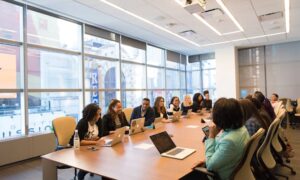The working world is changing, and remote work is on the rise, says Khuram Dhanani. While the trend was already growing, the COVID pandemic forced businesses to change their thoughts about the workplace and, indeed, its necessity.
For too long, there has been an assumption that employees need to be in an office environment to work in the most efficient and effective way. We now know that simply isn’t the case.
At this point, I should throw in a caveat. Homeworking is not necessarily the right option for every person or every role. It’s not an option to remove all elements of spending time with your employees or forget the importance of establishing and maintaining an excellent team spirit. But, implementations that consider the needs of both the business and its employees provide opportunities to both embrace and thrive within the digital workplace.
The Tools That Enable The Digital Workplace
By leveraging the power of digital tools, Khuram Dhanani believes we can create a modern, digital workplace that is more flexible, collaborative, and productive. Here are just a few of the ways that digital technology is transforming the workplace:
1. Enhancing Communication and Collaboration
One of the biggest challenges of remote work is maintaining effective communication and collaboration. Fortunately, there are several digital tools that can help with this, including video conferencing platforms like Skype and Zoom.
However, all tools can be misused, and that’s exactly what Harvard Business School found in their research into home workers. They identified that remote workers were being swamped with online meeting requests, resulting in lower levels of productivity and reduced staff morale.
Effective communication follows the same rules, whether it’s carried out online or in person. Creating and circulating a detailed agenda in advance, controlling the discussion, and ensuring that the conversation stays on topic all contribute to time effective and productive meetings.
2. Improving Productivity
There’s no question that working from home can be more productive than working in an office. After all, there are fewer distractions and more opportunities to focus on the task at hand. But digital tools can help take productivity to the next level. For instance, time tracking apps can help you identify and eliminate time-wasting activities. And productivity boosters can help you stay focused and on task.
3. Creating a Flexible Workplace
One of the great things about working from home is that it allows for a more flexible approach to work. No longer are you tied to a 9-5 schedule or a specific location.
Digital technology can make the workplace even more flexible. For example, cloud-based tools make it easy to access and share files from anywhere. As a result, it becomes essential for managers to focus on their team’s output rather than micromanaging their day-to-day activities.
Future Trends in Remote Working
We’ve already come a long way. Cloud-based storage and VOIP comms are two key examples of technology that have seen enormous growth in accessibility to the point of becoming standard tools within the workplace.
But what’s to come? What changes can we expect to see in the digital workplace?
Closure of the technology and business strategy chasm
As business and technology strategies become increasingly intertwined, it’s becoming clear that many organizations are being limited by their past technological choices. To move forward and beyond these limitations, it’s essential for a business to align the two.
And it’s not enough to produce a strategy that then sits on a shelf; effective execution requires a commitment to continual monitoring of strategic choices and making adjustments as needed.
It’s essential that the business strategists collaborate with tech leaders to ensure that the technologies support the organizational strategy, including the requirements of the remote worker.
Reinventing the Office
The office may not completely disappear, but it’s unlikely to ever return to its previous form. It’s anticipated that the work environment of the future will become much more flexible, still providing opportunities for collaboration but requiring less space.
Employees can anticipate a hybrid style of work with working from home supplemented with focused in-office sessions for those times when it’s essential to bring the team together without the clumsiness and hesitancy of online meetings.
When offices are kitted out with the same technologies used for remote working, then there is a seamless interface between the two. Creating a parity of experience between the office and remote workers enhances productivity and blurs the line between the two working styles.
Technology to enhance engagement, wellbeing, and collaboration
The opposers to remote working are quick to cite welfare issues as key stumbling blocks for the modern digital workplace. Their portrayal of isolated employees whose needs are unseen and so unheard paints a grim picture of remote working.
However, the reality is very different. In fact, technology can make it easier for the management team to quickly identify potential issues and take action before they have a negative impact on both the individual and the business.
Data generated through the digital workplace allows managers to quickly identify individuals who may be experiencing feelings of social exclusion and burnout.
Psychographic data informs the manager of their team’s values, attitudes and personality traits. This, in turn, allows informed decisions on how to best allocate the workload to ensure that each team member is challenged but not overwhelmed.
The Challenges Ahead
It’s said that there is no going back once you’ve had a taste of the future, shares Khuram Dhanani, and remote working has accelerated at a pace that simply could not have been predicted just a few years ago. But now that we have experienced the benefits of reallocating commuting time and costs, increased productivity, and achieved the freedom to work in a style that works each individual, the way in which we work has changed forever.




































